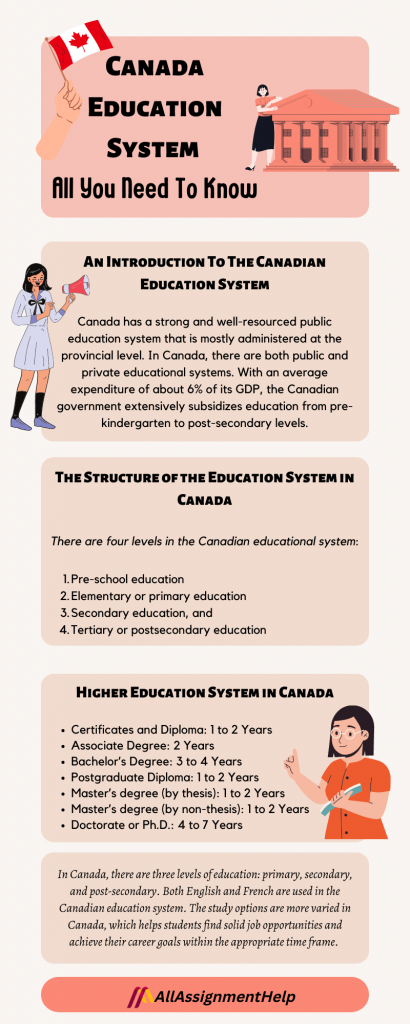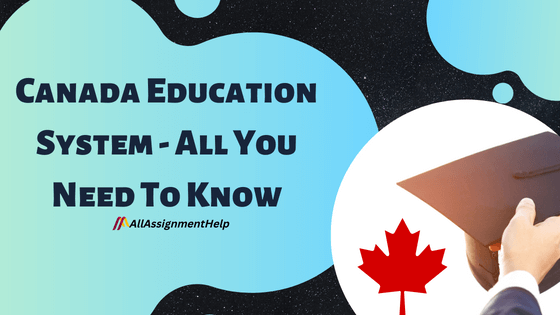Table of Contents
Canada is one of the most popular educational hubs in the world when considering where to study because of its esteemed and diverse educational system. The Canada Education System is among the greatest in the world with a well-funded and robust public education system. Moreover, Canada invests a lot of money in its educational system. According to the Organization for Economic Co-operation and Development, Canada ranks among the top three nations in the world for expenditure on public post-secondary education per person (OECD).
Are you considering going to study in Canada? Learning about the Canadian education system, institutions, and university culture in Canada may be beneficial for international students.
The information provided in this blog guide presented by All Assignment Help will hopefully help you make the decision to start your studies in this glorious country. So, without any further ado, let’s get started and understand all about the educational system in Canada.
A Little Introduction To The Canadian Education System
Canada has a strong and well-resourced public education system that is mostly administered at the provincial level. As a result, the educational system can differ in various ways between provinces. However, because the federal government is in charge of overseeing education, the level of education is uniformly high across the nation.
In Canada, there are both public and private educational systems. With an average expenditure of about 6% of its GDP, the Canadian government extensively subsidizes education from pre-kindergarten to post-secondary levels. This suggests that relative to other OECD nations, Canada spends more on education.
However, if you are planning to pursue your education in Canada and are worried about your assignments. There are many online Assignment Help services in Canada that can help you at any academic level.
Read Here: The Facts You Need to Know Before Attending a Canadian University
The Structure of the Education System in Canada
In Canada, immigrants and natives both have access to the same educational system. Up until the age of 16, all children must attend school. There are four levels in the Canadian educational system:
- Pre-school education
- Elementary or primary education
- Secondary education, and
- Tertiary or postsecondary education
Pre- School Education
In Canada, it is the first stage of education that is provided to kids between the ages of 4 and 5. Depending on your preference, you can choose among private, public, or federal schools that offer it.
Pre- School education is generally free for the first year. However, some provinces provide additional years of free education, such as Quebec, which provides free kindergarten for children from low-income families or those with abnormalities.
Elementary or Primary Education
Children in Canada must attend primary school beginning in Grade 1. It often begins around age six to seven and lasts through sixth grade (when the children are 11-12 years old). All of the subjects at this level are taught by the same teacher.
Math, reading, science, history, English or French, social studies, music, art, and physical education are some of the subjects covered in pre-elementary education. However, online assignment writing services in Canada help students with the above-stated subjects and minimize their academic stress of writing.
Secondary Education
The secondary level of education, usually known as high school, runs from Grades 9 to 12. The main goal of this phase is to assist students and get them up for the next educational level, with course demands expected to rise dramatically.
Regardless of the grade, students must remain in school until the age of 16 as mandated by law. Also, t provide students with the finest preparation for further education, Canadian high schools have carefully and intentionally constructed their curriculum.
Tertiary or Post-secondary Education
Students in Canada have the option to apply to colleges and universities once they graduate from high school. A smaller community college or a specialized technical college is typically considered a college in Canada. To better prepare for university and get transferable credits, many students in Canada enroll in community colleges as well.
Post-secondary Education starts with an undergraduate degree, is followed by a postgraduate program, and ends with a Ph.D. Although it doesn’t matter in which province of Canada you are pursuing your post-secondary education, you will always get assignment help services whether it be taking online assignment help in Toronto or in Vancouver.

Higher Education System in Canada
Now, let’s examine the higher education system in Canada.
Certificates and Diploma
- Duration: 1 to 2 Years
These are often technical programs that run up to two years and focus on practical job-related skills. These often vary based on the sort of course being taken, which can run anywhere between one and two years.
Associate Degree
- Duration: 2 Years
Typically, this degree is similar to the first 2 years of a bachelor’s degree. Students who have earned at least 60 credits of college-level coursework and a “C” on their general evaluation are awarded associate degrees.
Bachelor’s Degree
- Duration: 3 to 4 Years
An undergraduate degree is made available to students from other nations. The length of the course is determined by the province and the kind of curriculum a student chooses. However, in Canada, courses typically run for 4 years, with the exception of 3 years in Quebec. However, students can hire assignment experts for the completion of a bachelor’s degree with high scores.
Postgraduate Diploma
- Duration: 1 to 2 Years
Academically speaking, a Postgraduate Diploma is above a Bachelor’s degree but below a Master’s degree. A Postgraduate Diploma can often be started after a Bachelor’s degree has been earned, and it can be finished in one or two years.
Master’s degree (by thesis)
- Duration: 1 to 2 Years
For admission to this degree, prospective students must submit a research proposal. If accepted, they then work with a designated supervisor—typically a member of the university’s faculty—to develop a research-focused thesis. This degree program lasts up to two years.
Master’s degree (by non-thesis)
- Duration: 1 to 2 Years
This type of degree typically takes one to two years to complete and is taught rather than requiring a thesis. There are several lectures, seminars, and assessments that must be completed in the form of assignments, quizzes, and projects.
Doctorate or Ph.D.
- Duration: 4 to 7 Years
In Canada, a Ph.D. is usually needed for some courses that require a master’s. A Ph.D. takes 4 to 7 years to complete. A student or applicant is only given a Ph.D. after successfully presenting and defending their research in front of senior boards. However, if you are facing any difficulties at this level of study or need online dissertation help or research help, you can find a lot of professionals in Canada who will help you.
Other Types Of Education in Canada
Canada offers a wide range of education. Apart from providing education at the secondary or elementary level, the education system is divided into 3 school categories as well, which are:
Vocational Schools
Students have the option to learn a trade or profession at technical institutions located across Canada in addition to community colleges that provide vocational training. Canadian students who are interested in learning a particular trade can do so in vocational schools, where they can also acquire practical experience working in that field under the supervision of professionals. For example, they can enroll in managerial economics, management courses, or any other as per their area of interest.
Private Schools
In Canada, there are also private schools, which are those that are not subsidized by the government and usually have high costs. The parent and student must decide whether or not this is a worthwhile investment for them to undertake. In Quebec, private schools are commonly selected by individuals who can afford them but do not want to study in French.
Religious Schools
In Canada, with the exception of a few Catholic schools, parents who wish to enroll their children in religious education must do so through private organizations. These schools provide both the standard academic curriculum and the beliefs of the school’s particular faith.
Many schools receive significant financial support, giving students from all backgrounds an equal opportunity to pursue education. The Canadian government is working to expand this even further and give more young people who want to attend school options.
Canada Education System – Academic Culture
Canada is the most educated nation in the world with more than 50% of the population possessing a college degree and diploma. Now, moving forward, we will now discuss the academic structure of Canada.
Map of the Course
You should anticipate enrolling in five courses per semester, which together make up your program. Every week, there are two hours of lectures for each subject, followed by a tutorial lasting an hour in which a teaching assistant facilitates conversation centered on the lecture or the readings for the week.
Learning and Teaching Methods
Canadian universities are committed to research and excellent instruction, but they also want to give their students the opportunity to succeed in the classroom, in the workplace, and in life. Lectures and tutorials are both used in university courses. Instructors deliver lectures to groups of between 30 and 200 students. They generally include a related element, such as a laboratory or a presentation.
Multiculturalism
Since Canada takes multiculturalism very seriously, you may anticipate studying among a diverse student body and learning from international academics (or at least having experience working abroad). However, online homework help services in Canada are always there to help you with matriculation as per the educational guidelines in Canada.
Academic Year
In Canada, September is often the month with the highest number of student registrations and is the main month when students enroll in universities. While the majority of schools and colleges provide the September and January intake, you may also be able to receive confirmations during the summer admission period, which starts in April or May. In addition, admission to Community Colleges and University Colleges often occurs three times a year.
Grading System
There are various grading systems used in Canada when an international student applies for a higher education program. It varies depending on the region you are in the university you have chosen to attend, or the type of study you want to pursue. However, the grading scale used in Canada can fluctuate from 4.0 to 9.0. Additionally, each university or region uses a different ratio of number grades, alphabetical grades, and percent.
Also Read: Subjects Where Students Mostly Seek Assignment Help in Canada
The Last Words!
In Canada, there are three levels of education: primary, secondary, and post-secondary. Both English and French are used in the Canadian education system. The study options are more varied in Canada, which helps students find solid job opportunities and achieve their career goals within the appropriate time frame. The Canadian Constitution’s authority over a sizable number of excellent educational institutions has led to an efficient educational system in Canada.
However, if you are planning to study in Canada, you can take help from us at any stage with your assignment and homework writing.
FAQs
| Q: What about the cost of schooling in Canada? A: Canada offers affordable advanced learning compared to other nations. The annual cost of tuition fees for a student could be between 20,000 and 30,000 CAD. The average price may change depending on the school and program in which you are participating. |
| Q: Can overseas students seek master’s degrees in Canada work part-time jobs? A: Yes, overseas students may work up to 20 hours a week while enrolled in classes. They might also work full-time throughout the summer months. |
